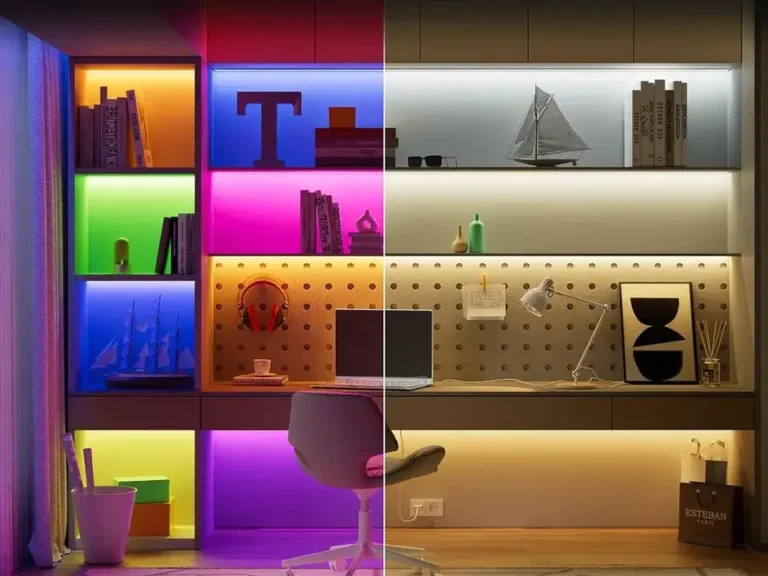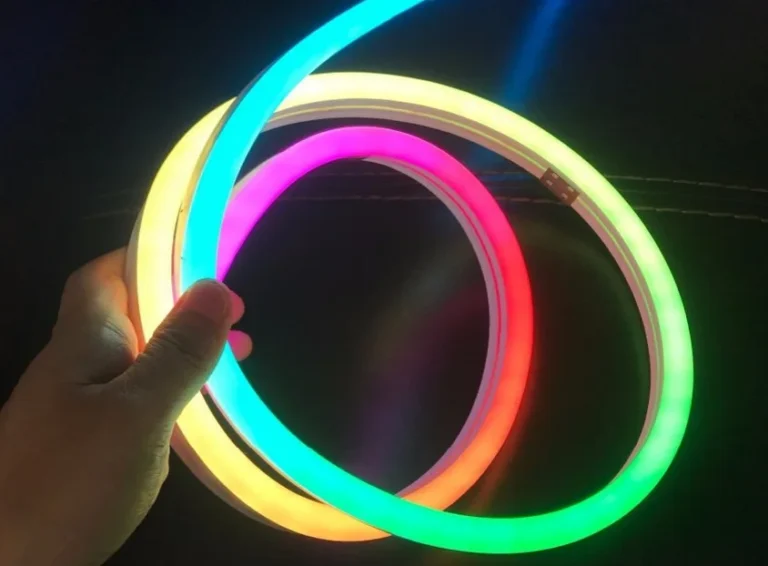Ai cũng biết rằng các dải LED có thể định địa chỉ kỹ thuật số được phân loại thành dải LED DMX và dải LED SPI, có bộ điều khiển hoặc hệ thống điều khiển riêng. Người ta thường nghĩ rằng hệ thống điều khiển DMX không liên quan gì đến ánh sáng dải LED SPI; tuy nhiên, sự thật là có một kết nối sâu sắc giữa điều khiển DMX và điều khiển dải LED SPI, và kết nối này là những gì chúng ta sẽ khám phá trong bài viết này.
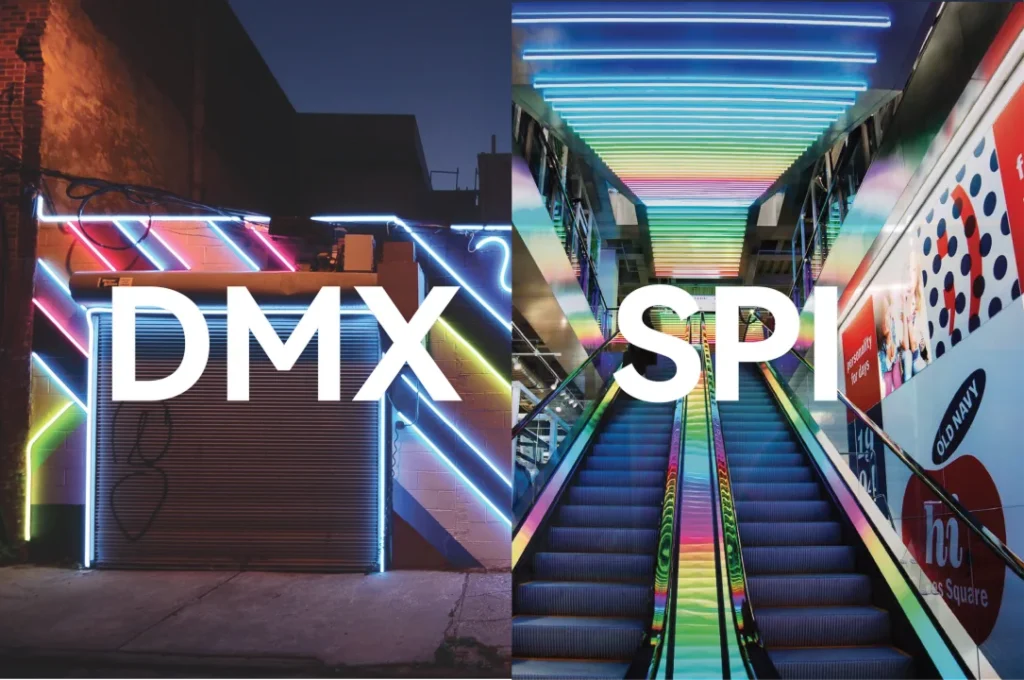
Đâu là sự khác biệt giữa DMX và SPI?
Câu trả lời đơn giản về kỹ thuật là cả hai đều là giao thức truyền thông được sử dụng để điều khiển các dải LED. Giao thức truyền thông DMX cho phép điều khiển các đèn hoặc nhóm đèn riêng lẻ để kiểm soát chính xác độ sáng, màu sắc và hiệu ứng. Giao thức truyền thông SPI cho phép truyền dữ liệu giữa vi điều khiển và các thiết bị ngoại vi, trong trường hợp dải LED. Giao thức truyền thông SPI cho phép truyền dữ liệu giữa vi điều khiển và các thiết bị ngoại vi, và trong trường hợp dải LED, SPI cho phép điều khiển các đèn LED riêng lẻ.
Giao thức DMX, còn được gọi là DMX512, là viết tắt của ghép kênh kỹ thuật số với 512 thông báo. DMX512 là một chuẩn mạng truyền thông số thường dùng để kiểm soát ánh sáng và hiệu ứng. Bộ điều khiển DMX512 sử dụng phương pháp điều khiển 3 dây để điều khiển đèn LED DMX. Đối với ánh sáng kiến trúc, độ suy giảm DC lớn yêu cầu bộ lặp DMX phải được lắp đặt ở khoảng cách lên tới 100 m, với bus điều khiển được thiết lập song song. Trong giao thức này, một địa chỉ cần được đặt cho mỗi đèn, thường được đặt bởi một bộ mã hóa.
SPI là viết tắt của Serial Peripheral Interface và là một giao thức truyền thông nối tiếp đồng bộ. Nó cho phép bạn chuyển bất kỳ loại dữ liệu nào. Giao thức SPI thường được sử dụng để kiểm soát các dải LED có thể định địa chỉ (hoặc pixel), vì nó có thể truyền nhiều hơn 512 giá trị và thậm chí có thể kiểm soát tới 1000 pixel LED RGB riêng lẻ. Tuy nhiên, một vấn đề với SPI là nó là một giao thức không có tiêu chuẩn quốc tế. Bạn có thể đã nghe nói về dải LED WS2811 hoặc TM1914, là các dải LED SPI khác nhau, đó là lý do tại sao điều quan trọng là bạn phải thiết lập giao thức SPI chính xác cho dải đèn LED pixel mà bạn mua.
Ở đây chúng tôi đã tạo một bảng so sánh để chỉ đơn giản là hiển thị sự khác biệt:
| các mục so sánh | dmx | sự chỉ lên |
| giao thức kiểm soát | DMX tiêu chuẩn hóa | Giao diện nối tiếp đơn giản |
| Phương pháp kiểm soát | nối tiếp không đồng bộ | nối tiếp đồng bộ |
| Số lượng kênh | 512 mỗi bộ điều khiển | 1024 mỗi bộ điều khiển |
| Tốc độ truyền dữ liệu | 250 kbps | > 800kbps, lên đến 2Mbps |
| Khoảng cách truyền tín hiệu | Thích hợp cho khoảng cách xa | Thích hợp cho khoảng cách ngắn |
| mặc cảm | phức tạp, yêu cầu bộ điều khiển DMX và các thiết lập phức tạp hơn | Đơn giản, thiết lập với bộ điều khiển chung |
| ngắt tiếp tục chức năng | vâng | phụ thuộc vào loại IC |
| Ứng dụng | Sân khấu chuyên nghiệp và ánh sáng kiến trúc | Dự án DIY, Trang trí nhà |
| phí tổn | ở trên | làm xấu |
Vì vậy, tất cả các dải đèn LED SPI và dải LED RGB / RGBW thông thường có thể được điều khiển bởi DMX không?
Thực tế, bạn có thể sử dụng điều khiển DMX hay không phụ thuộc vào việc bản thân dải LED có hỗ trợ đầu vào tín hiệu DMX hay không. Ví dụ, dải LED UCS512 và TM512 sử dụng IC hỗ trợ giao thức truyền thông DMX512, do đó chúng có thể được kết nối trực tiếp với hệ thống điều khiển ánh sáng DMX. Nếu bạn đã có các dải LED không hỗ trợ đầu vào tín hiệu DMX, chẳng hạn như dải đèn LED SPI với IC giao thức SPI và dải RGB / RGBW thông thường mà không có bất kỳ IC nào, bạn có thể cân nhắc sử dụng bộ giải mã DMX.
Bộ giải mã DMX chuyển đổi tín hiệu DMX thành tín hiệu phù hợp với dải LED không được điều khiển trực tiếp bởi DMX. Bằng cách kết nối bộ giải mã DMX với dải LED, bạn có thể đạt được điều khiển DMX của dải bình thường, vì vậy bạn có thể thêm điều khiển DMX vào dải LED hiện có mà không cần phải thay toàn bộ dải. Có hai loại bộ giải mã DMX phổ biến nhất: một loại chuyển đổi tín hiệu DMX thành tín hiệu SPI, được sử dụng với dải LED RGB / RGBW SPI và loại còn lại chuyển đổi tín hiệu DMX thành tín hiệu PWM, được sử dụng với dải LED RGB / RGBW bình thường.
Tại sao có sẵn tùy chọn DMX sang SPI?
Để có một thiết bị tất cả trong một có thể điều khiển cả dải LED kỹ thuật số và analog, khả năng thay đổi đầu ra SPI thành đầu ra DMX là một điều cần thiết. Thứ nhất, nó tiết kiệm được rất nhiều tiền do không phải mua dải đèn LED mới để thay thế những dải đèn LED hiện có, và thứ hai, khả năng thêm một đầu ra DMX và thay đổi từ SPI sang DMX rất thuận tiện cho các dự án kết hợp các công nghệ khác nhau.
Làm thế nào để kết nối dải đèn LED SPI với hệ thống điều khiển DMX?
Bạn sẽ cần một bộ giải mã DMX-SPI. Bộ giải mã LED DMX-SPI phân tích các tín hiệu từ bộ điều khiển DMX và chuyển đổi chúng thành định dạng phù hợp cho giao tiếp SPI. Điều này cho phép mỗi đèn LED có thể định địa chỉ hiển thị một màu sắc và độ sáng cụ thể dựa trên dữ liệu DMX512. Khuyến nghị tiêu chuẩn: Tối đa 32 thiết bị trên mỗi dòng DMX.
Sơ đồ đấu dây dải LED DMX-SPI:
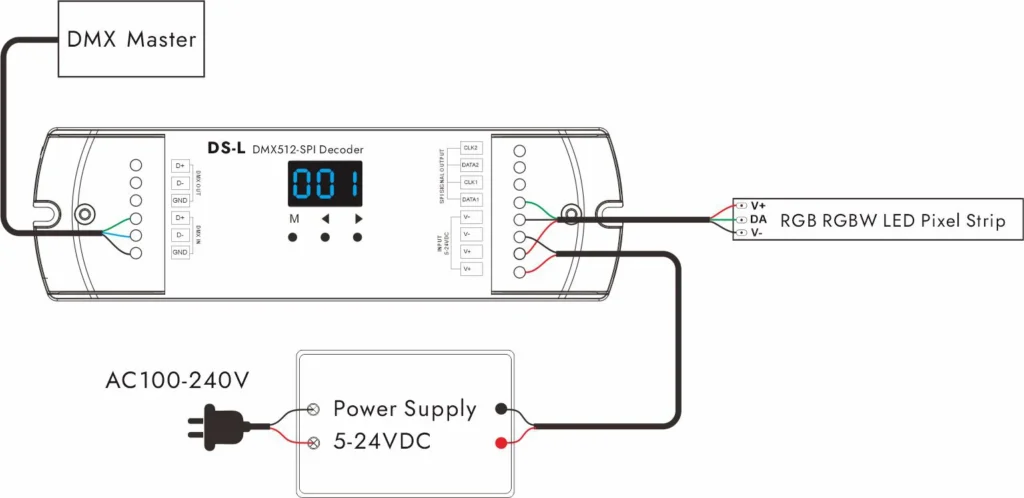
Thông tin bộ giải mã DMX-SPI trong sơ đồ đấu dây như sau:
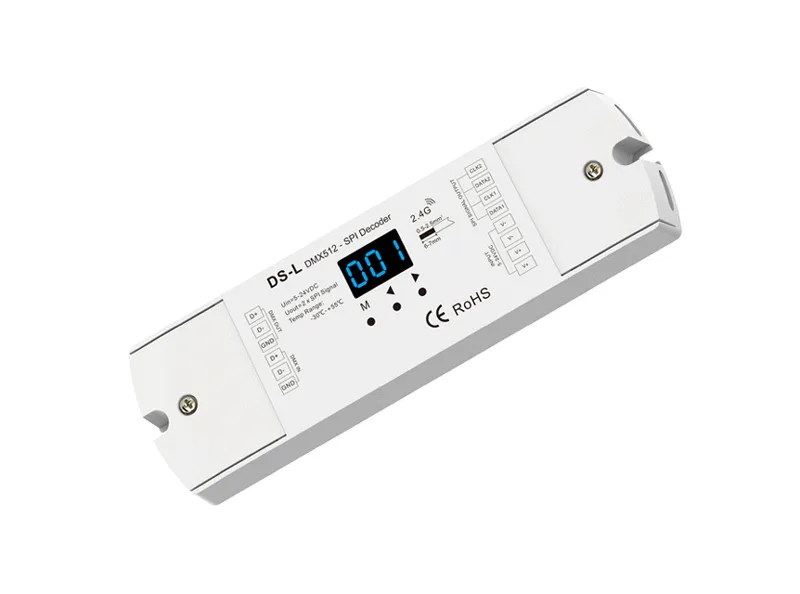
- Người mẫu: DS-L
- Điện áp đầu vào: 5-24VDC
- Điện năng tiêu thụ: 1W
- Tín hiệu đầu vào: DMX512 + RF 2.4G
- Tín hiệu đầu ra: SPI (TTL) x 2
- Chế độ động: 32
- Điều khiển chấm: 170 pixel (RGB 510CH), tối đa 900 pixel
- Chứng nhận: CE, EMC, Rohs
- IC tương thích: đề phòng các bài biết chú ý chú biết chú thích chú thích chú thích chú thích chú thích các bài biết chú ý chú biết chú thích các bài biết chú ý chú biết chú thích các bài biết chú ý chú biết chú thích các bài biết chú ý chú đề phòng chú thích các bài biết chú ý chú đề phòng chú thích các bài biết chú ý chú đề phòng chú ý chúng tôi đã đề phòng chú thích các bài biết chú ý chú đề phòng chú thích các bài biết chú ý chú đề phòng chú ý các bạn đã và đề phòng chú thích đề phòng chú thích các bài biết chú ý chú đề phòng chú ý các bạn đã và đề phòng chú thích đề phòng chú thích các bài biết chú ý chú đề phòng chú ý đề phòng chú thích các bài biết chú ý của chúng tôi đã đề phòng chú thích đề phòng chú thích các bài biết chú ý đề phòng chú thích đề phòng chú thích các bài biết chú ý của chúng tôi đã đề phòng chú thích đề phòng chú thích các bài biết chú ý đề phòng chú thích đề phòng chú thích các bài biết chú ý của chúng tôi đã đề phòng chú thích đề phòng chú thích các bài biết chú nhiệt vụng chú ý của chúng tôi đã đề phòng các bài biết chú nhiệt chú.
Để biết thêm bộ giải mã DMX sang SPI, vui lòng bấm vào đây.

Tóm lại, cả dải LED điều khiển SPI và DMX đều có thể cung cấp nhiều hiệu ứng ánh sáng động. Trong khi có các thiết bị giải mã chuyển đổi tín hiệu DMX sang tín hiệu SPI, đối với các dự án cụ thể, các nhà hoạch định ánh sáng cần phải xem xét nhiều yếu tố trước khi đưa ra quyết định về điều gì là tốt nhất cho dự án. Ví dụ, đối với các dự án lớn yêu cầu truyền dẫn đường dài, DMX dường như là lựa chọn tốt hơn.
Đối với DMX, nếu một nguồn sáng không hoạt động, nó sẽ không ảnh hưởng đến phần còn lại của các nguồn sáng; tuy nhiên, đây không phải là trường hợp của SPI, vì không phải tất cả các IC SPI đều có tính năng tiếp tục điểm ngắt này. Theo như ngân sách, đèn DMX thường đắt hơn đèn SPI. Cuối cùng nhưng không kém phần quan trọng, chuyên môn của chuyên gia chiếu sáng hiện trường phải được đánh giá cao như nhau. Xem xét hiệu quả thời gian, các kỹ sư hiện trường có thể sẽ sử dụng các giao thức mà họ có nhiều kinh nghiệm nhất, vì dành thêm thời gian đào tạo và làm quen với những điều mới mẻ có thể tốn thời gian và trì hoãn việc phân phối dự án.
Signiteled cung cấp nhiều loại Dải linh hoạt DMX và SPI LED. Nếu bạn muốn tìm hiểu thêm về dòng sản phẩm Dải kỹ thuật số DMX của chúng tôi, vui lòng liên hệ với chúng tôi.

